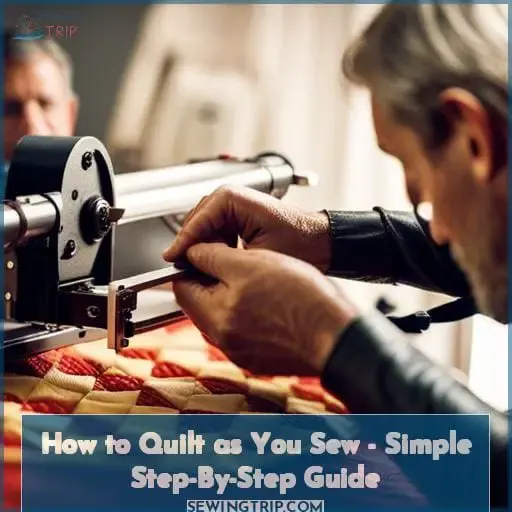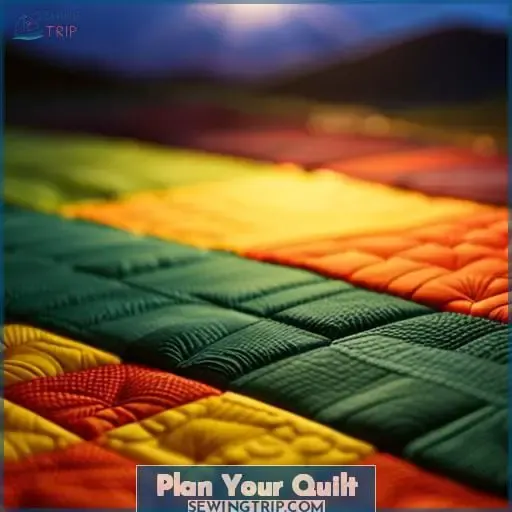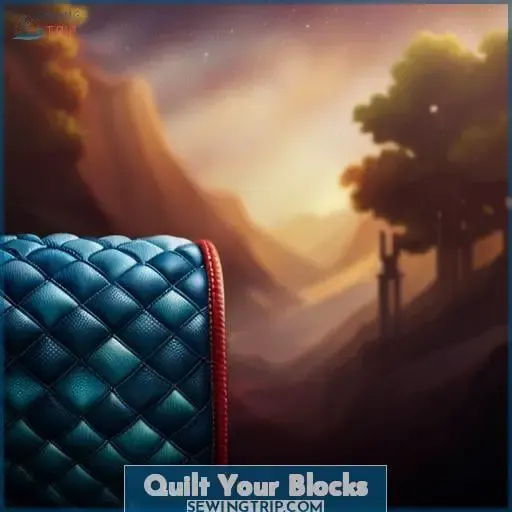This site is supported by our readers. We may earn a commission, at no cost to you, if you purchase through links.

If you’re one of them, you know the satisfaction of creating something beautiful and unique with your own two hands.
And if you’re looking for a way to make your quilting even more efficient, you’ll want to learn how to quilt as you sew.
With this technique, you can quilt your blocks as you’re piecing them together, which saves you time and effort in the long run.
So grab your fabric, thread, and sewing machine, and let’s get started!
Table Of Contents
Key Takeaways
- Decide on quilt design details like size and number of blocks early when planning
- Precisely layer backing, batting, and quilt top before basting quilt sandwich
- Quilt each block before joining them to save time and effort
- Carefully align edges when joining finished blocks to keep quilt flat
Plan Your Quilt
When you’re planning your quilt-as-you-go project:
- Decide on the finished size and number of blocks that will comprise your quilt so you can calculate the necessary materials.
- Focus on simple designs and plan for trimming your quilt blocks to consistent sizes.
- Yardage calculations are key – be sure to purchase enough fabric for your blocks, joining strips, backing, and binding.
- Consider using fabric scraps for the quilt back to minimize waste.
Once your blocks are quilted, you’ll join them before adding backing fabric.
With some thoughtful planning upfront, you’ll set yourself up for success assembling your quilt-as-you-go project.
Prep Your Blocks and Backing
Before constructing your quilt, essential prep work is required.
Trim your quilt blocks to the preferred finished size plus 1⁄4” seam allowance.
Calculate the exact backing size needed based on your quilt’s dimensions.
Maximize use of fabric scraps when piecing the backing together.
For the batting layer, trim to match the quilt top’s dimensions without any seam allowance.
Construct a basic quilt sandwich by layering backing wrong side up, then batting, centered evenly, and finally the quilt top right side up on top.
Align layers precisely before basting together in preparation for quilting.
With blocks and backing prepped meticulously in this manner, you’re ready to quilt as you sew using your preferred quilt-as-you-go technique.
Make a Quilt Sandwich
Once you’ve prepared your blocks and backing, you’ll sandwich the quilt layers together to create the quilt top.
Choosing the right batting is key – consider loft, fiber content, and stitch definition based on your quilting plans.
Here are some options:
| Type | Loft | Definition |
|---|---|---|
| Cotton | Low | Shows detailed quilting |
| Polyester | Medium | All-purpose batting |
| Wool | High | Defines stitching |
Baste the layers with pins, spray, or a temporary quilt stitch before quilting. This prevents shifting.
Now you’re ready to quilt creative designs like waves, swirls, or straight lines on your quilt sandwich!
Have fun quilting as you go.
Quilt Your Blocks
Next, you’ll quilt each individual block using either straight lines or free-form quilting.
Take care to avoid sewing into the seam allowance and use a marking pencil to indicate where you should stop quilting.
Carefully machine quilt each block in advance using straight stitching, gentle curves, or free-motion designs.
Consider marking the outer edges of the 1⁄4” seam allowance to remind yourself not to quilt past that point.
Focus on simple quilting motifs at this stage rather than complex filler designs.
Creative swirls, loops, pebbles, and grids work well.
Quilting now allows you to emphasize certain patchwork blocks and experiment with machine quilting before assembling the final quilt top.
Join Quilted Blocks
Once your blocks are quilted, it’s time to join them together into a finished quilt top.
Start by taking two quilted blocks and placing them right sides together, making sure all edges are aligned.
Then pin just along the very top raw edges so that your needle will only go through the quilt top layers as you stitch.
Align and Pin
Place the two blocks right sides together and pin the top layers to align them before sewing.
Position the blocks precisely, focusing on matching seams and points.
Secure with only a few straight pins to baste the layers.
Keep pins perpendicular to the edge for stability when feeding blocks under the presser foot.
Efficient joining relies on proper alignment before edge stitching.
Sew Blocks
After carefully aligning and pinning your blocks, you’re ready to frequently stitch the tops of the blocks together while avoiding sewing through the backing fabric.
Pin the quilt tops only, avoiding the backing.
Use small, frequent stitches.
Stitch along the seam line.
Press seams before adding the next block.
Press Seams
You’ll want to press the seams open after sewing blocks together. Proper pressing leads to neat, professional-looking results.
| Pressing Stage | Temperature | Steam | Pressure |
|---|---|---|---|
| Initial Press | Hot | Yes | Firm |
| Final Press | Warm | No | Gentle |
| Seams | Hot | Yes | Firm |
| Edges | Warm | No | Gentle |
Press seams open after stitching by placing them directly under the iron’s hot surface. Apply firm pressure while releasing steam to flatten seam allowances. Avoid stretching or distorting fabric shape.
For final seams, use a dry iron on warm to gently seal edges, maintaining piece shape and dimension.
Precise pressing leads to perfectly matched seams and neat block edges in your quilt as you sew the project.
Square Up Backing
Next, you’ll want to square up the quilt backing once all the blocks are joined to ensure the backing fabric lines up properly before joining the rows.
Carefully trim the quilt backing using a rotary cutter and quilter’s ruler, removing any excess fabric or uneven edges. This trimming technique helps improve alignment and prevent puckering when sections are joined.
As you trim, ensure corners are precisely square for proper seam matching. Adjust the backing piece by piece to achieve the needed dimensions.
Watch for distortion in seaming and realign pinned edges when sewing rows together.
Precise squaring lends to success sewing quilt-as-you-go and lets you progress smoothly through final steps.
Join Rows
Once you’ve joined your quilted blocks into rows, you’ll need to stitch those rows together to assemble your quilt top.
When joining rows, press seams in alternating directions for each row to reduce bulk.
If using multiple colors or fabrics, arrange rows according to your planned design, ensuring pleasing color combinations and flow.
For additional stability when joining, consider cotton batting options instead of polyester.
Mark quilting designs on paper first to visualize spacing and density.
As rows grow in length, switch to a walking foot and larger throat space for ease of manipulation.
Simply take your time, and seam finishes will neatly match at each junction across the quilt.
Quilt Backing
After joining the rows together, it’s time to quilt the backing. This helps secure all the layers and gives it that wonderful crinkly quilted texture. I like to use fabric scraps for the quilt backing whenever possible. It helps utilize my stash and is budget-friendly.
- Make the backing at least 2 inches wider and longer than the quilt top. This extra helps when handling the quilting.
- Sandwich the top, batting, and backing with a 1⁄4 seam allowance on all sides.
- Now the fun part: quilt! Start from the center and use simple stitch-in-the-ditch or free motion designs across the backing to secure the layers.
- Consider a quilt-as-you-go joining method for the backing if working in sections.
Bind Quilt Edges
After quilting the backing, you’ll bind the quilt edges to finish it off.
To bind your quilt, cut bias or straight grain binding strips. Join them into one continuous piece using diagonal or straight seams.
Leaving an 8 tail, sew binding to one quilt edge, mitering corners and overlapping ends.
For a decorative touch, consider scalloped or zigzag edges using pinking shears, or try a flange binding.
Binding completes your quilt with a polished look and protects edges from wear.
Experiment with colors and prints – binding frames your quilt and lets your creativity shine.
Conclusion
With determination and a few sharp needles, you’ll find there’s truly no limit to what you can create with the quilt-as-you-go method!
Patterns, perfection, and precision matter less than the pride you feel gazing upon that blanket of scraps you stitched with your own hands.
So push onwards, dear quilter, and may each ragged seam and uneven corner remind you of the journey behind it.
















